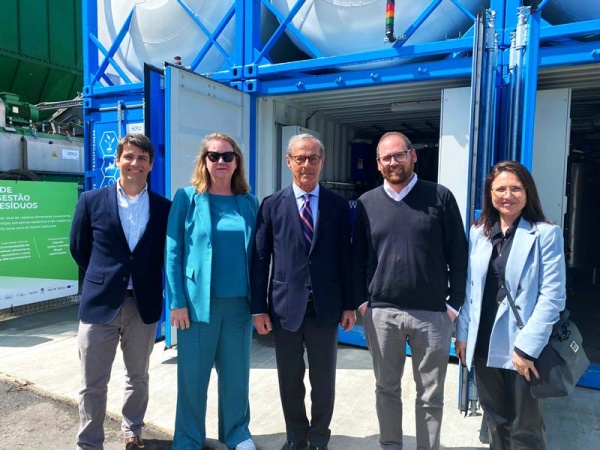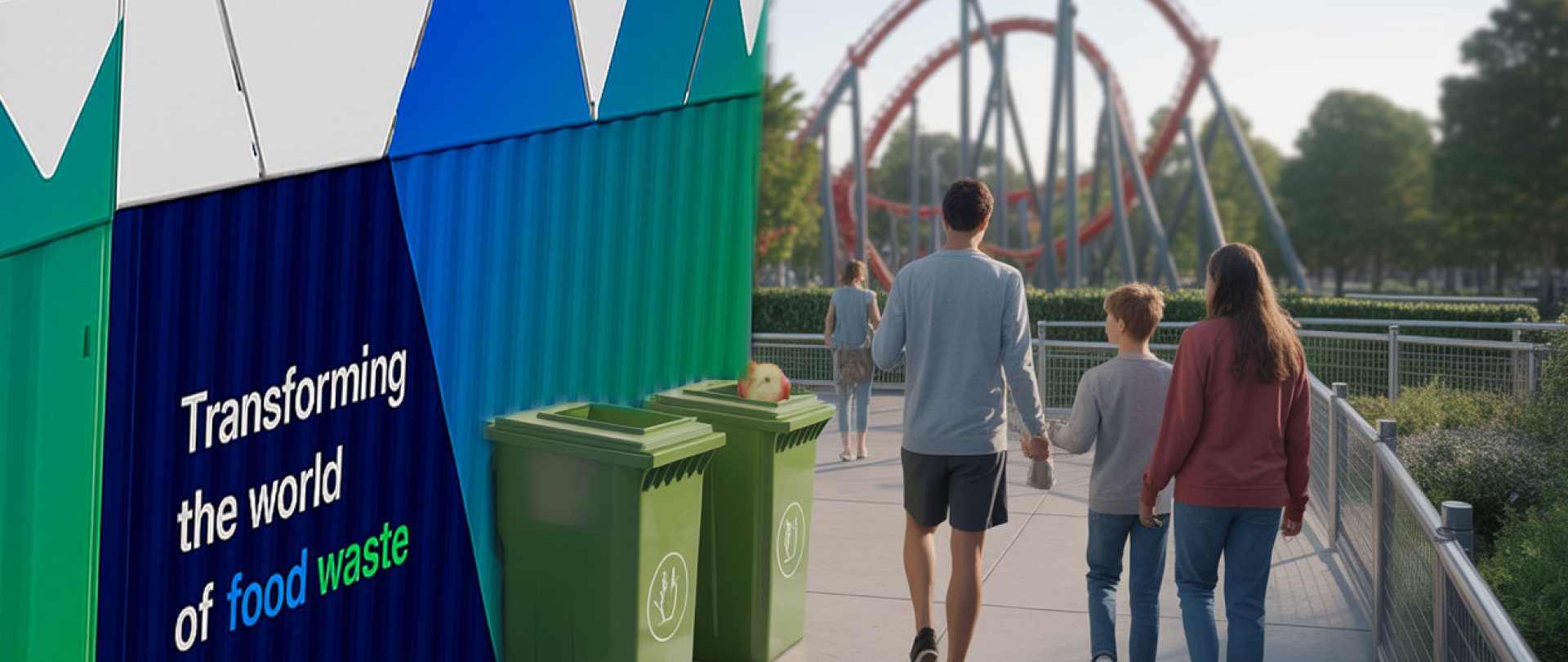
Why visitor nudges matter: small design choices, big behaviour shifts
- Make the greener choice the easy choice. If visitors can arrive by public transport using a combined Transport + Park ticket, many will. Bundle transit into your pricing, show the time savings in your app, and position the Public Transport entrance as the fast lane.
- Default to better: offer reusable cups as standard with a small deposit and make single‑use the opt‑out. Place rinse/return points where people actually stand (queue exits, food courts).
- Choice architecture at waste bins: larger openings for organics, color-coded lids, lighting and scent cues near food zones, and bin “hosts” during peak hours. Short, friendly copy beats lectures: Apple cores here = tomorrow’s flowers.
- Social proof and feedback: screens or signs that update live—“Together, visitors diverted 2,100 kg of food waste today from incineration”—drive repeat participation.
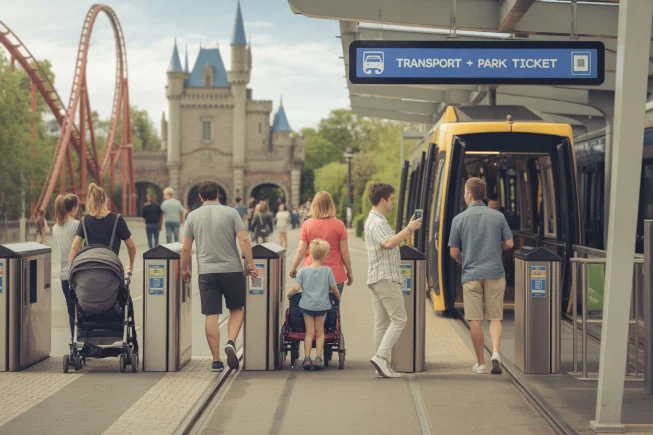
The food-waste problem hiding in plain sight.
When food waste goes into the grey bin, two things happen:
- It typically ends up incinerated or landfilled—releasing avoidable emissions and wasting the embedded energy and nutrients, accounting for Scope 3 emissions.
- It contaminates your other waste materials, making plastics, paper, and cardboard wet and unrecyclable—quietly driving up costs and down recycling rates.
The good news: food waste is a high‑value waste stream when collected clean. Through anaerobic digestion, food waste makes biogas (for electricity/heat) and nutrient‑rich digestate that is ideal as liquid fertilizer—turning a cost center into a circular resource.
What EU law now requires (and why it matters to theme parks)
- Separate collection of bio‑waste is mandatory across the EU: by 31 December 2023, bio‑waste must be separated and recycled at source or collected separately—not mixed with other waste.
- Municipal recycling targets are rising: 55% by 2025, 60% by 2030, 65% by 2035—making clean food waste streams critical to compliance and cost control.
- Separately collected recyclables and bio‑waste should not be incinerated; the intent is valorization via recycling or biological treatment, reinforcing the business case for clean organics capture on site.
In short: separating food waste isn’t just “nice to have”—it’s a legal requirement, a cost lever, and a reputational win.
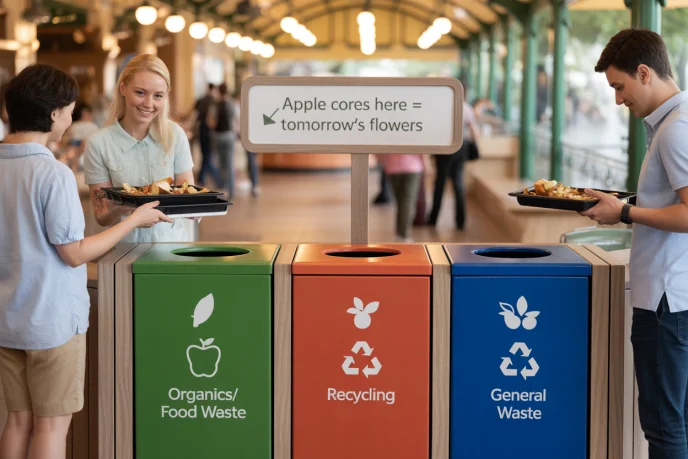
Practical solutions theme parks are adopting
- Design your food courts for increased sorting success:
- Pre‑sort counters at tray return points.
- Staffed “sorting ambassadors” during peak hours.
- Small signs with photographs of real park food items.
- Switch packaging to compostable only where it truly improves outcomes (and ensure your biological treatment can handle it).
- Build a back‑of‑house organic waste flow: sealed wheeled bins, short transfer distances, and daily treatment. On‑site treatment reduces transport, odors, and emissions.
- Close the loop visibly: use the outputs of valorized food waste (energy and fertilizer) on site so visitors and staff see the benefits where they happen.
On‑site biodigestion as a visitor‑facing sustainability feature
A containerized, on‑site Waste Transformer biodigester quietly turns your park’s food waste into:
- Electricity and heat to power park needs.
- A liquid organic fertilizer (digestate) ideal for keeping gardens, planters, and bloom beds lush.
Why this works for theme parks:
- A Waste Transformer is compact, airtight without smell, it's modular, and sits behind the scenes—but you can make it part of the story. A short, safe viewing path with playful signage can turn food waste handling into a mini‑attraction. People can walk by, eat their apple, and learn that their apple core helps co-power the park.
- Bloom‑bed storytelling: small signs—“These flowers are fed with nutrients recovered from yesterday’s lunch”—connect visitors to the cycle in seconds.
- Tangible touchpoints: phone‑charging lockers powered by the Waste Transformer biodigester’s clean electricity let visitors literally “feel” the power of food waste transformation while they eat.
- Education without preaching: simple signs that show “today’s green energy from food waste,” “meals’ worth of energy generated,” and “liters of fertilizer produced for our gardens” make the impact real and translation to real world examples.
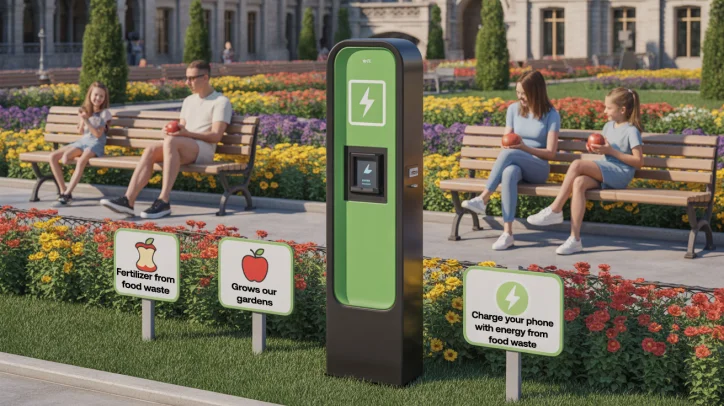
Why on-site biodigestion fits the regulatory and business context
- With a Waste Transformer, parks valorize food waste in line with EU expectations for separate collection and recycling of organic waste.
- Supports higher recycling rates by keeping food out of the mixed stream—protecting the value of plastics, cardboard, and paper.
- Cuts transport distance and emissions versus hauling all food waste off‑site.
- Creates a local natural fertilizer source for horticulture teams, reducing chemical inputs, irrigation water and costs, and enhancing biodiversity areas with natural nutrient recycling and allows green communication about these efforts.
What visitors want (and how sustainability strengthens the offer)
Families choose theme parks that are seamless, safe, and satisfying—and they increasingly notice sustainability in action. Europe’s leading parks demonstrate that strong attendance pairs with strong experiences; Europe as a region saw steady gains in 2023 as operators invested in guest‑focused improvements. Flagship parks, from Disneyland Paris at 10.4 million visitors to Europa‑Park at around 6 million, show the scale—and the opportunity to engage millions in a positive, hands‑on sustainability journey.
A simple roadmap to get started
- Map your food‑waste hotspots: buffets, quick‑service areas, kiosks, and staff canteens.
- Fix the basics: great bin design and placement, service‑line training, and real‑time feedback.
- Align procurement: packaging that matches your treatment pathway; clear labelling agreements with vendors.
- Pilot a visible loop: a small viewing corridor by the Waste Transformer biodigester, bloom‑beds with “fed by yesterday’s leftovers” signs, and a phone‑charging point.
- Communicate positive and often: “You just made clean power,” beats “Don’t do this.” Make it fun.
- Report and celebrate: share monthly progress with your team; post a “Green Day” stat to your park app.
If you take one thing away
Sustainability doesn’t have to sit off‑stage. By nudging arrival choices, designing for easy waste sorting, and turning food waste into visible power and green gardens on site, you improve operations, meet EU requirements, and give families a story they want to be part of. That’s a win for your brand, your budget, and your visitors—today and on every return visit.
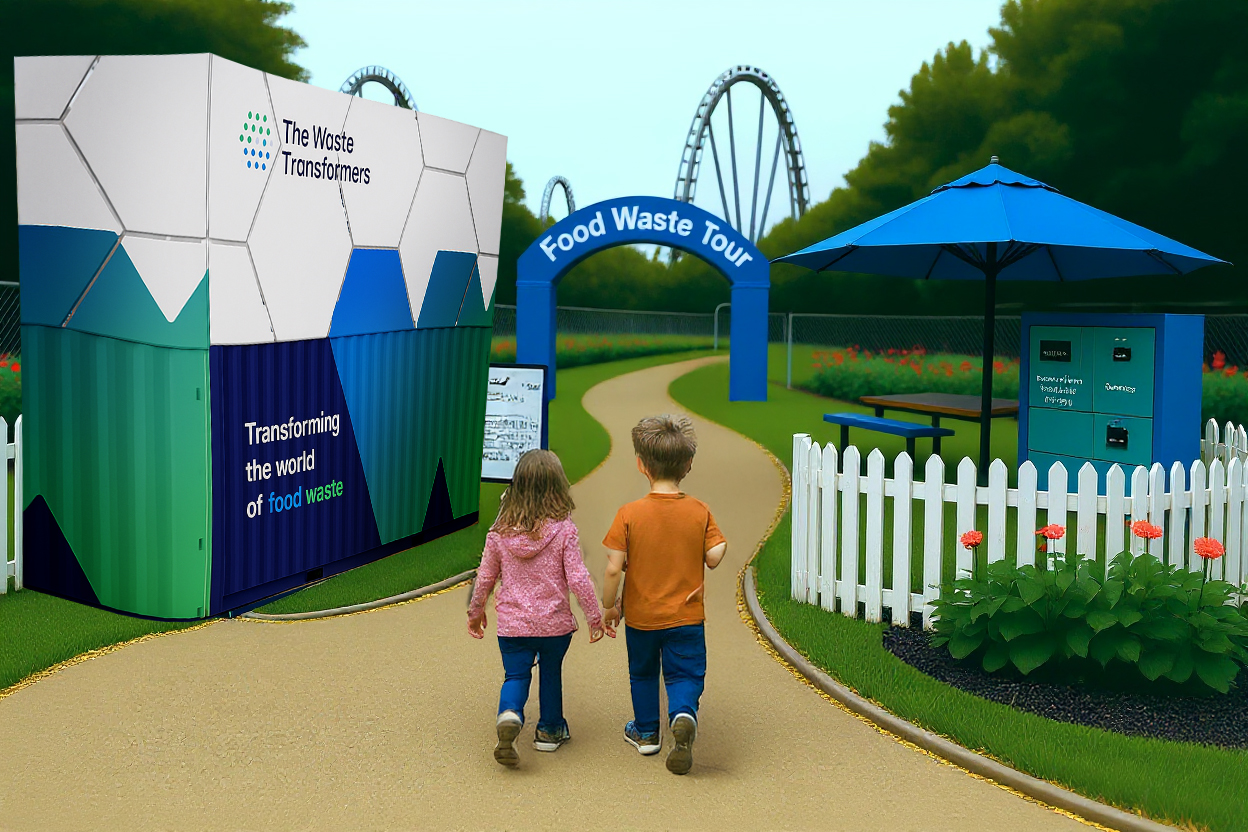
Climate leadership pays off
- Guests want seamless, value‑rich days out—and they notice sustainability woven into the experience.
- EU law requires separate collection or at‑source recycling of bio‑waste from 31 December 2023, with rising municipal recycling targets.
- Cleanly captured food waste can be turned into energy and fertilizer via on-site anaerobic digestion; using outputs on site makes the loop visible and memorable.
- On‑site Waste Transformers biodigester, clear bin design, and smart nudges (including bundled public transport) create measurable impact—without feeling like pointing fingers.
- Europe’s parks are growing again; tying guest experience to real circularity is how leaders will stand out.
Related news articles

Lineage and The Waste Transformers celebrate successful hackathon against food waste
Amsterdam, the Netherlands, 21 September – Lineage, one of the leaders in cold chain logistics, today announced the successful conclusion of its hackathon event, partnered with The Waste Transformers ‘Tackling Food Waste for a Sustainable Future’. The event took place over two days in Amsterdam, with the final day at the Eye Film Museum, and brought together some of the brightest minds of student and startup teams as well as NGOs and supply chain leaders from across Europe for an intense few days of innovation, collaboration and problem-solving.